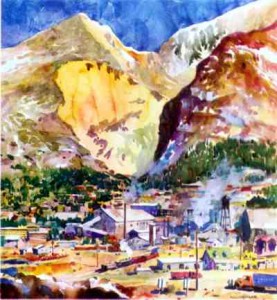Article by Shanna Lewis
Local Musician – June 2006 – Colorado Central Magazine
WILD APPLAUSE, WHISTLES AND CHEERS. It’s not the typical response a bunch of high school kids usually give an instructor after a lesson, is it? Yet that’s what happened at the end of a recent performance at Salida High School by a master percussionist known simply as Bones.
“Drums are powerful. They speak to something inside of us,” said the Salida-based musician.
Focused on the mission, “to unite youth with the global community through world music,” his school performances have a couple of unusual features.
Bones plays solo, but you’d never know it if you were just listening and not watching. Percussion instruments of all kinds fill the stage: congas, a djembe, timbales, a steel drum, shakers, an electronic marimba, and a standard issue drum set. Off to one side sits some high tech gadgetry that allows him to record the sounds from each instrument and his own voice in separate segments that replay in continuous loops as he performs.
Starting with a simple rhythm played on one instrument, he progressively adds and layers new sounds and beats into the emerging opus. Never still for long, the tall lanky man dashes from one instrument to the next. His hands and arms are in motion, sweat drips from his forehead, and his whole body moves with the music as he uses foot operated switches to mix the sounds. African, Latin and contemporary techno rhythms pulsate through the auditorium and the music grows with each stop. The result is a complex and compelling creation that throbs with a global sound.
Using looping technology to produce music live in front of an audience creates a number of challenges. Bones’ performance relies heavily on soundman, Carey Hallett, to keep the show going.
“We’re doing it all with acoustic percussion instruments, aside from my electronic marimba, so that means open mics on stage. It’s been quite a challenge,” said Bones. “We’ve had to develop a lot of equipment and build a lot of stuff from scratch because its never been done before.”
Stories and interesting tidbits of information about the instruments and the cultures they’ve come from are liberally sprinkled throughout the performance.
After watching Bones perform for students, it’s easy to see why he loves to work with kids, and why kids love him. He’s playful and authoritative at the same time.
A fascinating story about the origins of the steel drum on the Caribbean island of Trinidad provides him with a forum to talk about history and social change. The story goes something like this:
Back in the thirties Trinidad had a terrible gang problem. Unique rhythms were used to call the gangs to war so the government outlawed first drums and then bamboo poles. Not to be deterred, the gangs began to use common household items that couldn’t be outlawed, like pots and pans and trash can lids, to call their members to battles. Those banged up trash can lids were the genesis of the first steel drums and the gangs’ signature rhythms morphed into a full musical tradition. It’s a story of how drums went from being a harbinger of violence to becoming a symbol and expression of a new cultural heritage.
[Bones performing]
HE HAS THE KIDS’ ATTENTION. The beat of the global music is infectious and the kids are energized and interested in learning more. The students leave the performance with a new appreciation of the origins and social impacts of the music they’ve heard — along with new ideas about a variety of other topics.
Performances in schools are just one part of several multidisciplinary programs created by Bones and his partner, schoolteacher Jill Rolak. If schools are interested they can request lesson plans to use prior to the performance to get the kids doing their own research on the various instruments and music. An optional post performance workshop provides a venue for the kids to continue learning by building and playing their own instruments — along with singing and dancing. Designed to align with Colorado education standards, the skills and subjects presented in the lessons include reading, writing, foreign language, history, geography, and music.
Bones takes a holistic view of the program. “Young people need to know that just about everything in life has come from one place or another and is a fusion of different cultures, especially in this country, and to find out the origins of it is pretty intriguing,” he said.
His passion for percussion started at a young age but he wasn’t encouraged at first. “Dad wouldn’t let me play the drums. I had to play the trombone. By the time I was in eighth grade, I really wanted a drum set but my parents said ‘no.’ They weren’t mean, they just said ‘you can earn it’ and so I did. I got a job and got my first drum set,” he said adding, “They wouldn’t let me practice unless they weren’t home. Which was probably the best thing they could have done cause I’d champ at the bit waiting for them to leave so I could get on my drum set and practice. I played my two beats and one fill incessantly, so I don’t blame them for not wanting to hear that over and over again.”
Drums stayed a part of his life, after he left home. Time spent on the east coast as part of a Coast Guard search and rescue team offered the opportunity to apprentice with jazz drummer Chicky Reagan.
Eventually he decided to head to England to study at Drum Tech, where he expanded his knowledge of percussion.
Playing with assorted groups such as Shakedown Street, a Grateful Dead cover band, as well as teaching percussion provided all kinds of interesting experiences, including travel abroad.
BONES TELLS THE STORY of a three-week trip to Cuba with a small group of his students to study Latin drumming and history along with dancing. He said they were openly received by the locals and able to do things that the average tourist might not be able to because he and the students were genuinely interested in the indigenous music, dance and culture.
“We were able to go to three Santerias because we were studying percussion. I actually got to play at a Santeria,” he said, referring to the special Cuban healing ceremonies.
Cuba, he said, “cemented his love of Latin and African rhythms.”
There were times that he drifted away from drumming on a professional level. Bones once worked for the sculptor John Okulick in Los Angeles and later became a ski instructor at Monarch and a river and outdoor guide in Belize as well as in the western United States.
Nonetheless, drums have always had an impact on him. He said, “I’ve met an amazing variety of people in all walks of life because of the drum. It’s been a thread throughout my life. Whether I’m on the river or skiing or whatever it is I’m doing, it’s usually connected in some way to my playing the drums.”
Bones sees a connection between the visual arts and music. “With music you’ve got silence as a blank canvas. What do you want to do with that silence? If you have a blank canvas what do you want to do with it?”
Playing with Jaka, an African style marimba band was a catalyst for Bones to get more involved with African instruments and beats. When he first hooked up with the group, he had never played marimba.
“And I was just intrigued when I saw them. Mind blowing powerful African rhythms interlaced with polyrhythms on polyrhythms, phenomenal stuff. I had to be a part of it and they just happened to need a drummer, so fortune shined again.”
Bones was thrilled with the new dimensions that he was able to add to his music. “The African style of drumming is actually a lot simpler then you might think but very difficult to play. It’s another world of music that is subtle yet so complex,” he said.
His time with Jaka also provided the basis for his current endeavors to use music for educational purposes. “We did a lot of educational assemblies and workshops for kids. I just saw that it put such a light in the kids eyes and that’s what sparked it,” he said.
JAKA SPLIT UP, so last year he and Rolak sat down and worked out programs and teaching tools for all grade levels based around his music, and he’s been pleased with the response he’s gotten from the kids.
“They’re truly intrigued by the sounds that I’m making. Some of their questions are pretty deep,” he said.
Recognizing that schools don’t always have the space in their budgets to pay for these kinds of programs, he and Rolak have formed a non-profit organization called Windspark Guided Discovery, and hope to find funding so that they can bring the programs to schools for free. One of their shared dreams is to put together a youth marimba band, where kids would learn to make their own instruments, play them and then eventually be able to perform.
In the meantime, he’s taking his show on the road — to schools for educational events and to venues like the Salida Steam Plant, where in April, he played to a sell out crowd. Bones is scheduled to perform at the Tabor Opera House in Leadville at 7 p.m. on Friday, July 14. He also teaches workshops and private classes for adults and children. For tickets or additional information visit his website at www.bonesdrums.com .
Shanna Lewis is a staff reporter and photographer for the Wet Mountain Tribune in Westcliffe. Her work as an independent producer is regularly featured on KRCC FM’s regional radio newsmagazine Western Skies.


